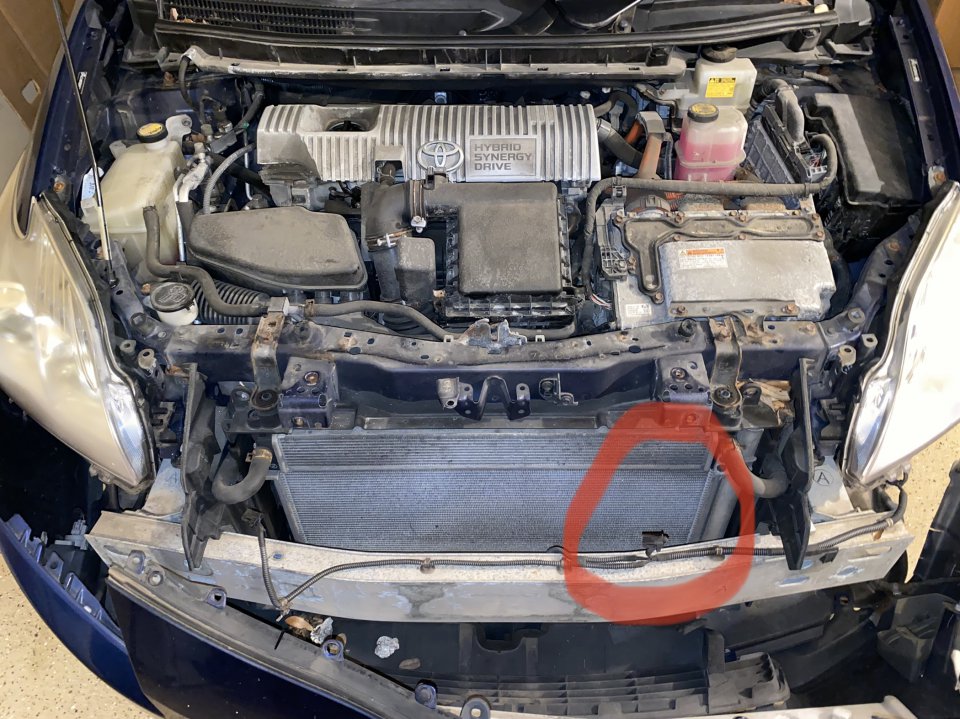Troubleshooting a 2008 Toyota Prius often starts with battery or electrical issues. Common problems include failing hybrid batteries and malfunctioning dash displays.
Owning a 2008 Toyota Prius comes with its set of unique challenges and rewards. This eco-friendly vehicle, known for its excellent fuel efficiency and low emissions, has won the hearts of many environmentally conscious drivers over the years. Yet, like any car, it’s not immune to issues, particularly as it ages.
Owners might encounter problems ranging from the hybrid battery life to the regenerative braking system. Recognizing these issues early can save time and money. This guide aims to help Prius owners identify common troubles and understand their vehicle better. With a focus on simplicity and clarity, we’ll explore key troubleshooting tips to keep your Prius running smoothly.
Introduction To The 2008 Toyota Prius
The 2008 Toyota Prius marks a significant step in automotive history. Known for its hybrid technology, the Prius became a favorite for those seeking efficiency and eco-friendliness. This model year continued Toyota’s tradition of providing a reliable and cost-effective vehicle, suitable for a wide range of drivers.
Popularity And Reliability
The Prius earned its reputation through consistent performance and innovative design. In 2008, it stood out as a top choice for eco-conscious consumers. Its reliability is backed by strong sales numbers and positive owner feedback. Here are key points that highlight its success:
- High resale value due to demand
- Low maintenance costs compared to peers
- Proven track record of durability
Common Issues Faced By Owners
Despite its strengths, the 2008 Prius has known issues. Owners report problems that range from minor inconveniences to more significant concerns. Below is a list of common issues:
| Issue | Description | Impact |
|---|---|---|
| Battery life | Hybrid battery may degrade | Affects performance |
| Braking system | Brake actuator may fail | Increases risk |
| Headlights | Headlights may shut off | Reduces visibility |
These issues are well-documented, making troubleshooting more straightforward for owners and mechanics alike.
Battery Life Concerns
The Toyota Prius is known for its eco-friendly hybrid technology. Battery health is crucial for performance. Over time, the battery may show wear. Recognizing symptoms of battery failure helps. Proper care extends battery life. Let’s dive into troubleshooting your 2008 Toyota Prius battery.
Symptoms Of Battery Failure
- Reduced fuel economy
- Dashboard warning lights
- Strange engine noises
- Slower acceleration
- Uneven power delivery
Watch for these signs. They suggest your Prius battery may be failing. Early detection is key.
Extending Your Prius Battery Life
Maintaining your Prius battery is essential. Follow these steps:
- Avoid extreme temperatures
- Keep the battery charged
- Perform regular maintenance
- Use eco-friendly driving modes
These practices help keep your Prius running smoothly. They save you money on replacements.
Handling Dashboard Warning Lights
The dashboard of your 2008 Toyota Prius is like a communication hub. It alerts you to your car’s health. Understanding these alerts can prevent small issues from becoming big problems. When a warning light flashes, it’s time to decode its message and act swiftly to ensure your Prius stays in peak condition.
Deciphering The Warning Signals
Your Prius dashboard uses colors and symbols to talk to you. Red means ‘urgent’. Yellow suggests caution. Green or blue signals are usually informational. Here’s a quick guide:
| Color | Symbol | Action |
|---|---|---|
| Red | Battery | Check your hybrid system immediately. |
| Yellow | Engine | Service soon. Could be an emission or sensor issue. |
| Green | Headlights | Lights are on or high-beam is in use. |
Remember, symbols vary. Your owner’s manual has them all.
Immediate Actions To Take
Spot a light? Don’t panic. Follow these steps:
- Stop the car if the light is red. Safety first.
- Check your Prius manual. It explains each light.
- Call for help if needed. Don’t risk driving if unsure.
Regular maintenance helps avoid surprises. Keep up with it.

Credit: www.reddit.com
Brake System Maintenance
Keeping your 2008 Toyota Prius stopping smoothly is crucial for safety. Regular brake maintenance ensures your Prius remains reliable on the road. Over time, brake components wear down, requiring inspection and service. We’ll explore common brake problems and share DIY care tips to keep your Prius’s brakes in top condition.
Identifying Brake Problems
Listen for unusual noises when braking. Squealing or grinding sounds may indicate worn brake pads. Feel for a spongy brake pedal; it often signals air in the brake lines. A vibrating steering wheel during braking suggests warped rotors. Watch for the brake warning light on your dashboard. It alerts you to potential issues within the brake system.
Diy Brake Care Tips
Maintaining your Prius’s brakes at home can save time and money. Check brake fluid levels monthly. Top up with the correct type if low. Inspect brake pads for wear every 6 months. Replace if less than a quarter-inch thick. Clean and remove debris from the brake calipers to prevent sticking. Test brakes after any maintenance to ensure proper function.
Use these steps to keep your 2008 Toyota Prius brakes responsive and efficient. Regular care prevents costly repairs and keeps you safe on the road.
Inverter Cooling System Issues
The 2008 Toyota Prius stands as a beacon of hybrid innovation. Yet, even the most robust systems face challenges. Inverter cooling system issues can hinder your Prius’s performance. This section delves into these challenges, highlighting signs of overheating and preventative tactics.
Signs Of Inverter Overheating
Inverter overheating spells trouble for your Prius. Recognize the signs early to avoid damage:
- Warning lights on your dashboard.
- Strange noises from the inverter.
- Reduced fuel efficiency, which hits your wallet.
- Car stalling or power loss.
Preventative Measures
Keep your Prius running smoothly with these steps:
- Regularly check coolant levels.
- Ensure the cooling system is clean.
- Replace old coolant timely.
- Inspect the inverter pump for function.
Address these issues early. Your Prius will thank you with lasting performance.

Credit: priuschat.com
Maximizing Fuel Efficiency
The 2008 Toyota Prius remains a top choice for those seeking economical transportation. Understanding how to maximize its fuel efficiency is key. Let’s dive into the best practices for ensuring your Prius runs as efficiently as possible.
Driving Habits For Better Mileage
Driving habits significantly impact fuel economy. Here are tips to enhance your Prius’s mileage:
- Accelerate gently: Quick starts consume more fuel.
- Maintain steady speeds: Use cruise control when possible.
- Anticipate stops: Coasting to red lights saves gas.
- Minimize idling: Turn off the engine during long waits.
Routine Checkups For Fuel Conservation
Regular vehicle maintenance is crucial for fuel efficiency. Follow these guidelines:
| Checkup | Frequency | Benefits |
|---|---|---|
| Tire Pressure | Monthly | Correct pressure maximizes mileage. |
| Air Filters | Every 15,000 miles | Clean air filters improve engine performance. |
| Oil Change | Every 5,000 miles | Fresh oil reduces engine friction. |
| Spark Plugs | Every 30,000 miles | Efficient spark plugs ensure proper combustion. |
Hybrid System Warning
Owners of the 2008 Toyota Prius may encounter a Hybrid System Warning. This alert signals issues within the car’s hybrid system. Addressing these warnings promptly ensures the vehicle’s longevity and performance.
Understanding The Hybrid System Alert
The Hybrid System Warning light on your dashboard is crucial. It indicates a problem that could affect your car’s efficiency and safety. This light might flash for several reasons, such as battery issues, electrical problems, or cooling system concerns.
- Battery problems: The heart of the Prius.
- Electrical issues: Wiring and connections matter.
- Cooling system: Keeps the battery at the right temperature.
Troubleshooting Hybrid System Glitches
Early troubleshooting can prevent major repairs. Follow these steps:
- Check the dashboard for any alert codes.
- Inspect the hybrid battery cooling fan. Clean if necessary.
- Ensure the 12V auxiliary battery is charged and healthy.
- Scan the vehicle with a diagnostic tool for specific error codes.
Consulting a professional is wise if these steps do not resolve the issue. Specialists can offer deeper insights and solutions.
| Problem | Possible Cause | Action |
|---|---|---|
| Battery not charging | Faulty connections | Check and secure all connections |
| Overheating | Blocked cooling fan | Clean the fan |
| Warning light on | Various | Use diagnostic tool |

Credit: www.youtube.com
Diy Fixes For Common Problems
Owners of the 2008 Toyota Prius often encounter a few common issues. Luckily, many of these can be fixed at home. This guide provides simple solutions for frequent problems. Follow these steps to keep your Prius running smoothly.
Headlight TroublesHeadlight Troubles
Dim or flickering headlights are common in the Prius. Before paying for professional help, try these steps:
- Check the headlight bulbs. Replace them if they are burnt out.
- Examine the fuses. A blown fuse can cause headlight issues.
- Clean the headlight lenses. Over time, they can become cloudy.
- Inspect the wiring. Look for loose connections or damaged wires.
Solving Multimedia System Issues
The multimedia system in your Prius should be responsive and clear. If it’s not, consider these fixes:
- Reset the system. Sometimes a simple reboot can solve the problem.
- Update the software. Ensure your system runs the latest version.
- Clean the screen. A dirty screen can cause touch sensitivity issues.
- Check audio settings. Incorrect settings can affect sound quality.
With these tips, you can solve common Prius problems from your garage. Always consult your owner’s manual for more detailed instructions.
Professional Help Vs. Diy
Professional Help vs. DIY sparks debate among 2008 Toyota Prius owners. Some tasks are doable at home. Others need a mechanic’s touch. Understand when each choice fits your Prius needs.
When To Seek Expert Assistance
Complex repairs demand professional skills. Warning signs often warrant expert diagnostics. Consider these scenarios for expert help:
- Hybrid battery issues: Specialized knowledge required.
- Brake system failures: Safety comes first.
- Engine problems: Advanced tools needed.
- Transmission troubles: Expert intervention crucial.
Timely expert assistance ensures your Prius runs smoothly.
Resources For Toyota Prius Owners
Prius owners have various resources at their fingertips. Utilize them for informed decisions. Here’s a list:
- Owner’s manuals: First stop for DIY troubleshooting.
- Online forums: Connect with fellow Prius enthusiasts.
- YouTube tutorials: Step-by-step DIY guides.
- Toyota Service Centers: Trustworthy professional help.
Use these resources for effective troubleshooting strategies.
Enhancing Longevity And Performance
Owners of the 2008 Toyota Prius often seek ways to boost their vehicle’s longevity and performance. Proper care ensures the hybrid runs smoothly for years. The following sections outline essential practices and upgrades for the best Prius experience.
Regular Maintenance Schedule
Sticking to a regular maintenance schedule is key to a healthy Prius. A well-maintained car performs better and lasts longer. Let’s break down the crucial maintenance steps:
- Oil Changes: Every 5,000 miles or 6 months, whichever comes first.
- Air Filters: Replace engine and cabin air filters every 15,000 miles to ensure clean airflow.
- Tire Rotation: Rotate tires every 5,000 miles to maintain even wear and extend their life.
- Brake Inspection: Check brakes every 10,000 miles to prevent costly repairs.
- Battery Check: Inspect the hybrid battery health annually to avoid unexpected failures.
Upgrades Worth Considering
Some upgrades can improve your Prius’s performance. Consider these options:
| Upgrade | Benefit |
|---|---|
| Performance Tires | Enhance road grip and handling |
| High-Quality Oil | Reduce engine wear, improve efficiency |
| LED Headlights | Better visibility, longer lifespan |
| Hybrid Battery Fan | Keep the battery cool, prolong its life |
Each upgrade offers specific advantages. They work together to boost the Prius’s performance. Remember to choose compatible parts for the best results.
Frequently Asked Questions
What Is The Most Common Problem With Toyota Prius?
The most common problem with Toyota Prius involves its battery. Owners often report issues with battery lifespan and performance. Regular maintenance can help extend its life.
What Is The Red Triangle Of Death On A 2008 Prius?
The red triangle of death on a 2008 Prius signals a serious problem with the hybrid system or battery. It requires immediate attention from a professional mechanic to diagnose and resolve the issue, ensuring the vehicle’s safety and reliability.
How To Reset A 2008 Toyota Prius?
To reset a 2008 Toyota Prius, turn the car off, press and hold the power button for a few seconds until it turns on again, and then release. This simple step can reboot the system. For deeper issues, consult the owner’s manual or a professional.
What Is The Signs Of A Prius Battery Going Bad?
Signs of a failing Prius battery include reduced fuel efficiency, inconsistent power, strange engine noises, and dashboard warning lights.
Why Won’t My 2008 Toyota Prius Start?
A dead battery or faulty starter might be the culprits. Check these components for any issues.
Conclusion
Navigating through your 2008 Toyota Prius’s issues can be straightforward with the right information. Remember, regular maintenance is key to longevity. Should problems arise, consult a professional mechanic. Thanks for reading, and drive safely—your Prius is counting on you!
















